It sounded almost too good to be true – the chance to go and ride in an undiscovered gravel paradise and play a small role in how its future is shaped. Obviously, Olly didn’t need too much arm twisting and packed his SPF50 sunscreen before heading off to the far side of the world. It’s a tough life, isn’t it…..
“I can’t believe we’re still in the car park and it’s already been 10 out of 10” said Gaby. There’s something almost surreal about being treated like a rock star when you arrive at an airport after a long flight. Being whisked through fast-track security, then guided through the baggage collection and customs clearance maybe wasn’t that eye opening (although it was incredibly welcome) but as we left the terminal building, we were greeted by a small troupe of local musicians. They paraded in front of us, banging drums, singing and dancing as they led us into the car park to meet our support crew for the week.

After a long flight what you probably need (apart from a wee!) is something to eat and drink. Luckily, even as the dance troupe were doing incredibly impressive hand-springs across our bit of the car park, a mobile chef was busy preparing our lunch on a gas fired grill, while his assistants chopped the top off a fresh coconut and handed them to everyone. If making a good first impression is important, then the team behind our gravel riding reccie trip to Sri Lanka had already scored full marks.
Being invited on a dream press trip as a journalist is a slightly difficult preposition. When the invite originally landed in my inbox, I genuinely thought it was a scam, as it sounded too good to be true. “Would you like to come to Sri Lanka and join a reccie group to see whether it would work as a destination for gravel riders?” What kind of question is that - of course I would!
But it does come with some serious expectations. When someone else is paying for your trip, they expect (not unreasonably) to get some decent exposure in return for their investment. What if you don’t enjoy it? The gravel trail network may not be up to scratch. Perhaps we’ll all get food poisoning within the first 24hours. Or, if you believed the BBC weather forecast, maybe we’ll all drown in a tropical rainstorm.
But we needn’t have worried. From the minute we were whisked through the airport, it became an absolute dream trip. And as for a destination for future gravel riders - let me cut to the chase here - Sri Lanka is like gravel riding utopia. It has so much potential, such breathtaking scenery, people so lovely you want to take them home with you, unlimited gravel trails/dirt tracks and food to die for. And did I mention the wall-to-wall sunshine?
Of course, there is an elephant in the room. How do we defend the carbon footprint of flying to the other side of the world “just” to ride our gravel bikes? From a purely environmental perspective it’s very hard to justify. The trip sponsor, Sri Lanka Airlines, realise this - long haul flights have a large negative impact on the environment after all. So, they’re making huge efforts to try and balance out the negative by implementing a raft of environmental and social mitigation measures.
On our first evening, after checking in to a beautiful beachside hotel and sitting open-mouthed through a video presentation which showcased quite how stunning Sri Lanka is, we were whisked a short distance up the coast to witness at first hand one of the airline’s environmental projects - a mangrove regeneration project.
Mangrove trees can absorb carbon 2-4x faster than tropical rainforest which makes them a big help for balancing out some of the impacts of our flight. They also help minimise the impact of high tides/storms/tsunami etc. by being a physical barrier between the ocean and the quieter brackish and freshwater lagoons that lie inland of them.
When our boats arrived at one of the mangrove nursery projects that Sri Lanka Airlines support, we were greeted by something from a Hollywood film set - what appeared to be a floating bar, lit by lanterns and with a small chef station set up alongside. As our captain gently beached our boat on a sand bar, we removed our shoes and climbed, slightly trepidatiously, over the side. The shock of standing mid-calf deep in the bath-water warm lagoon was pretty impressive and there were some audible intakes of breath from my fellow gravellers.
If this was just the first evening of our trip, the airline was certainly pulling out all the stops to create a spellbinding impression. As we sipped freshly poured cocktails and the sun slid gently into the Indian Ocean, I had to keep pinching myself to check whether I was actually dreaming. The support crew handed around plates of piping hot locally caught prawns cooked in coconut milk batter.
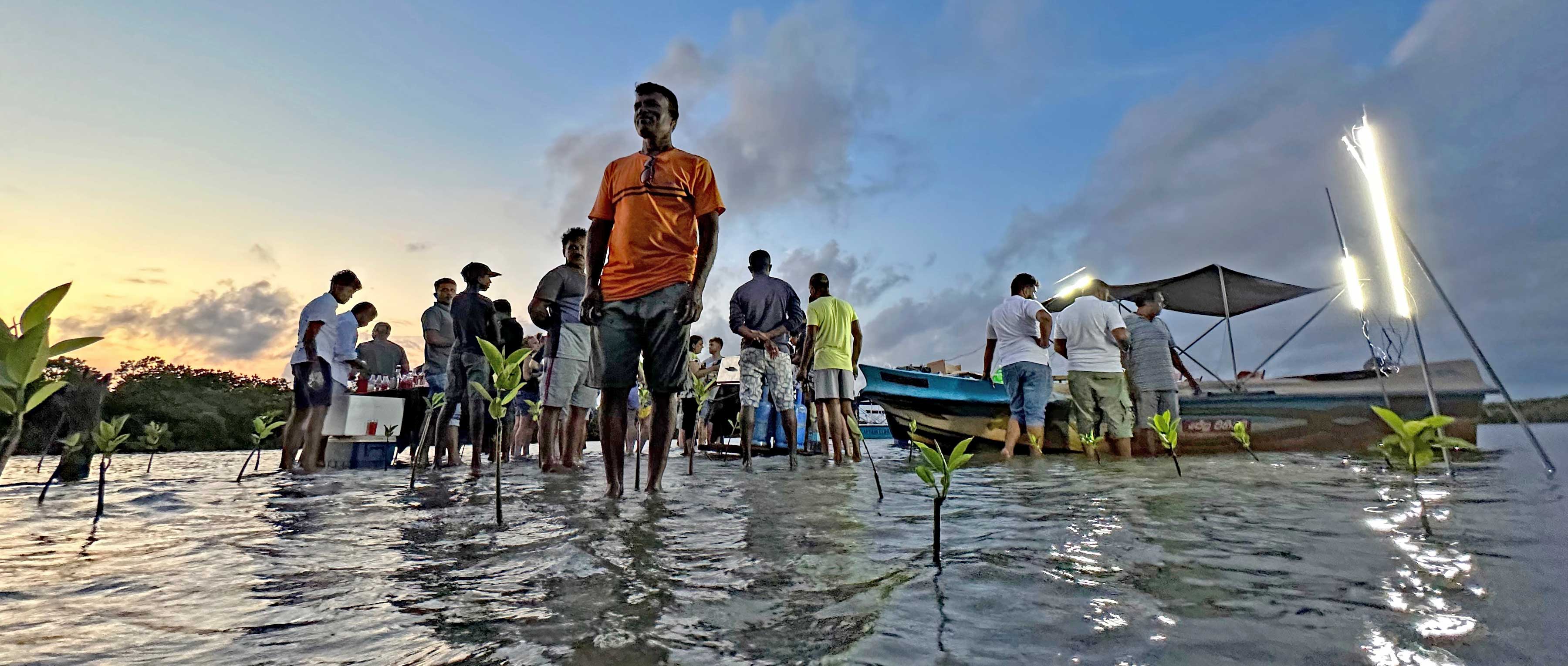
The prawns had been sourced from the lagoon and the staff explained how the traditional process of prawn fishing worked - using wooden stakes made from mangrove wood to create a small ‘trap’ into which the prawns were washed as the tides ebbed and flowed. The staff also explained that they were also finding research into how to modernise this traditional process to avoid the need to chop down mangrove trees to create the stakes. Another of the benefits that the airline was bringing to the local community was in training local people to work in the tourism sector. Whether this was funding local guide training schemes or exposing support staff to different experiences and activities, the benefit of our trip would hopefully slowly migrate out into the wider community.
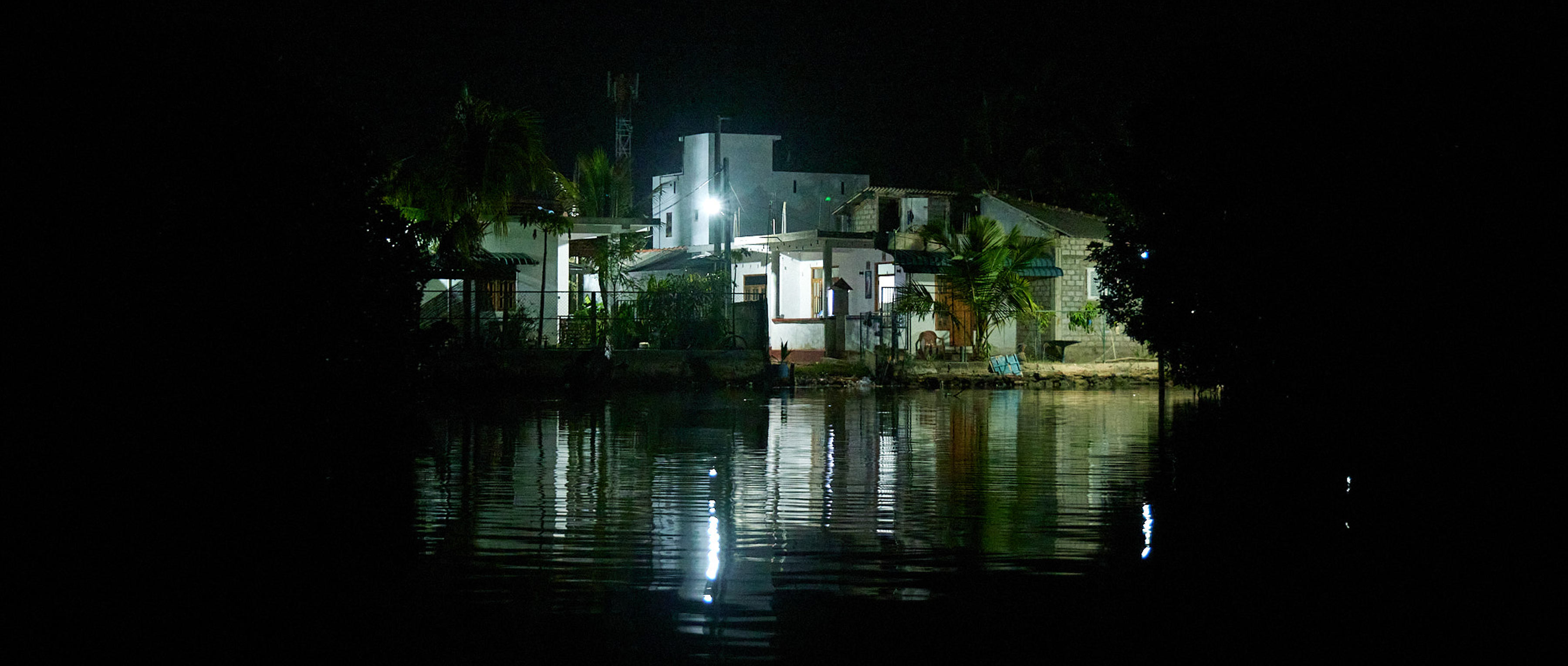
Image courtesy of Michael Blann
As day became night, our small flotilla of boats was ably steered back into harbour by their respective captains (who clearly had better night vision than their passengers) and after a delicious dinner and some rapid bike building, we headed to bed, dreaming of the gravelly adventures to come.
Day 2 dawned with a super early start (which we were soon to be accustomed to) and a quick pre-breakfast stroll on the beach to capture some shots of traditional sail-powered fishing boats heading out to sea. As huge dense thunderclaps built on the horizon, I had a horrible feeling the BBC doom-and-gloom weather forecast was going to prove true. As the group enjoyed an impressive buffet breakfast, the clouds burst and rain bounced off the floor. If we had been in Europe, I would have been a bit disconsolate, but as Sarunjan, our incredible group organiser, told us in a pre-trip WhatsApp message, Sri Lankan rain is generally both warm and short lived.
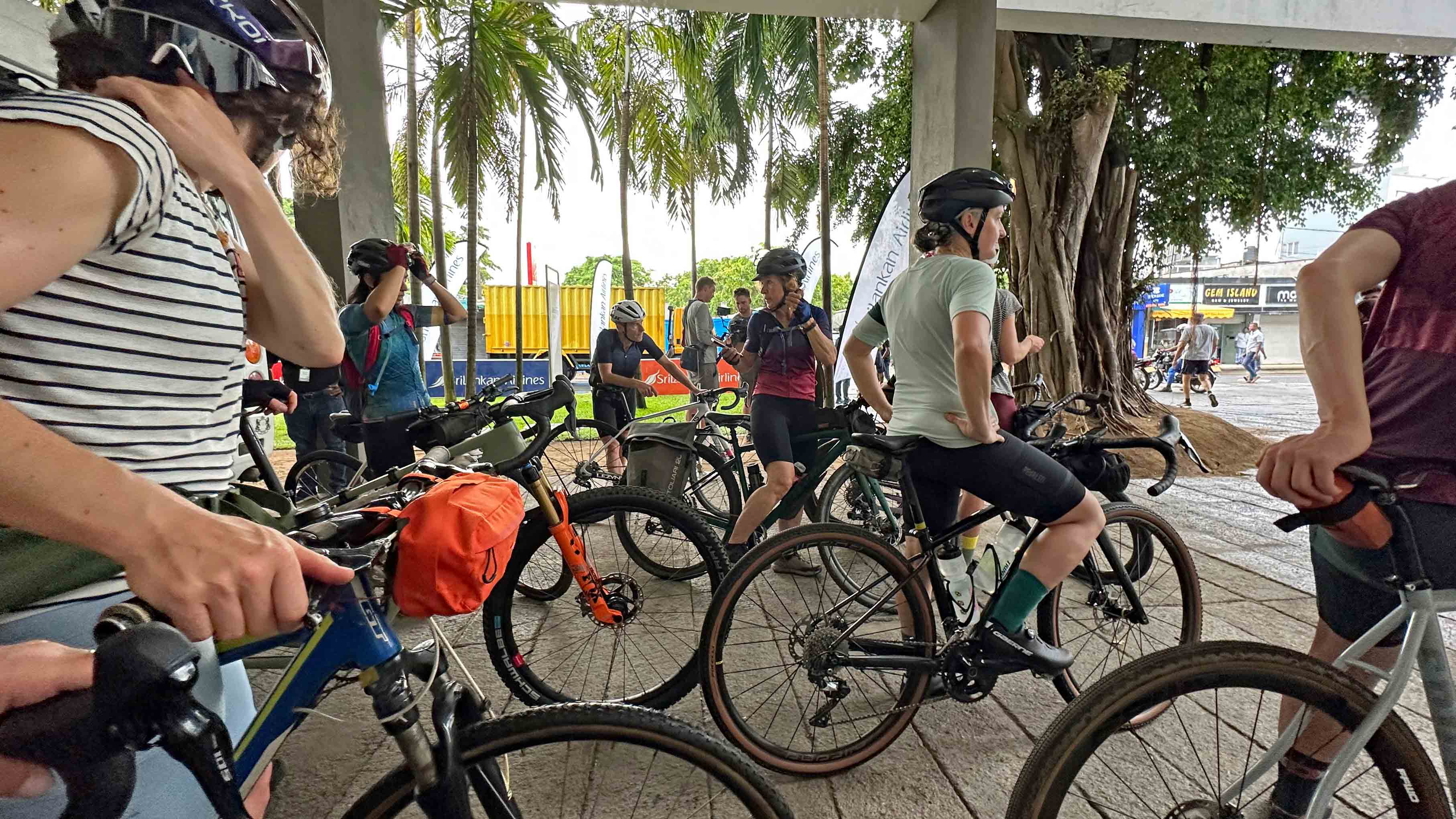
We were supposed to meet at 6.45am and leave shortly afterwards, but first morning faffage delayed this somewhat. I wasn’t the only one showing a few pre-ride nerves as we rode up and down under the hotel’s vast concrete portico, testing our bike’s functionality and deciding what clothing to wear. When it’s already mid-30s degrees, was it worth putting on a rain cape or would we just turn into an even sweatier mess than we already were? I initially put overshoes on (apologies to the fashion police) but swiftly removed them as the rain stopped and the ground started to steam.
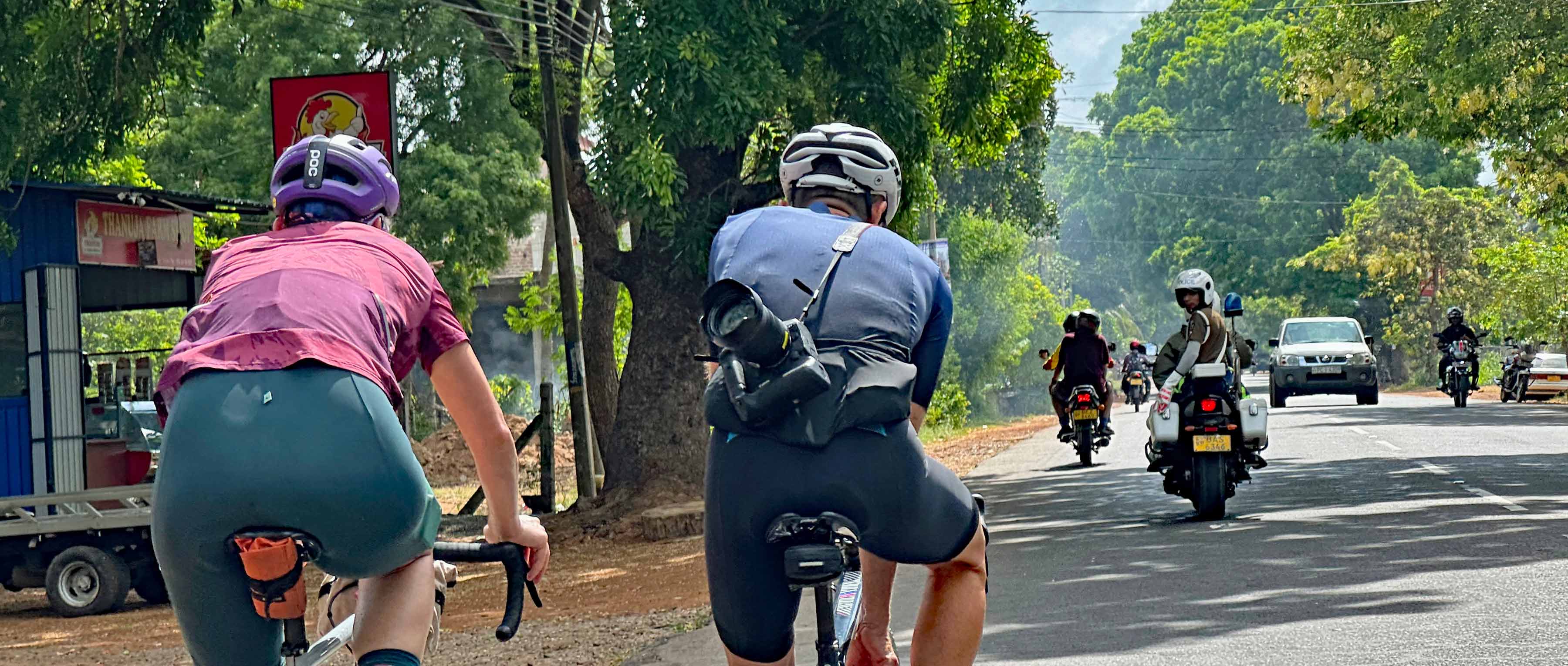
With our vast entourage, which included a police motorbike at the front and finished with two paramedics in an ambulance at the back, finally assembled we rolled out. The feeling of being members of royalty was reinforced, as Mayura and Krishnan (our police motorbike escort) cleared a path for our mini peloton. Mayura expertly piloted the bike, while Krishnan, soon christened Mr Jazz Hands, sat on the back and marshalled the traffic by wearing a vast pair of bright white leather gauntlets. The traffic was astoundingly compliant with his commands and both oncoming and with-flow drivers moved to the side to let us through unhindered.
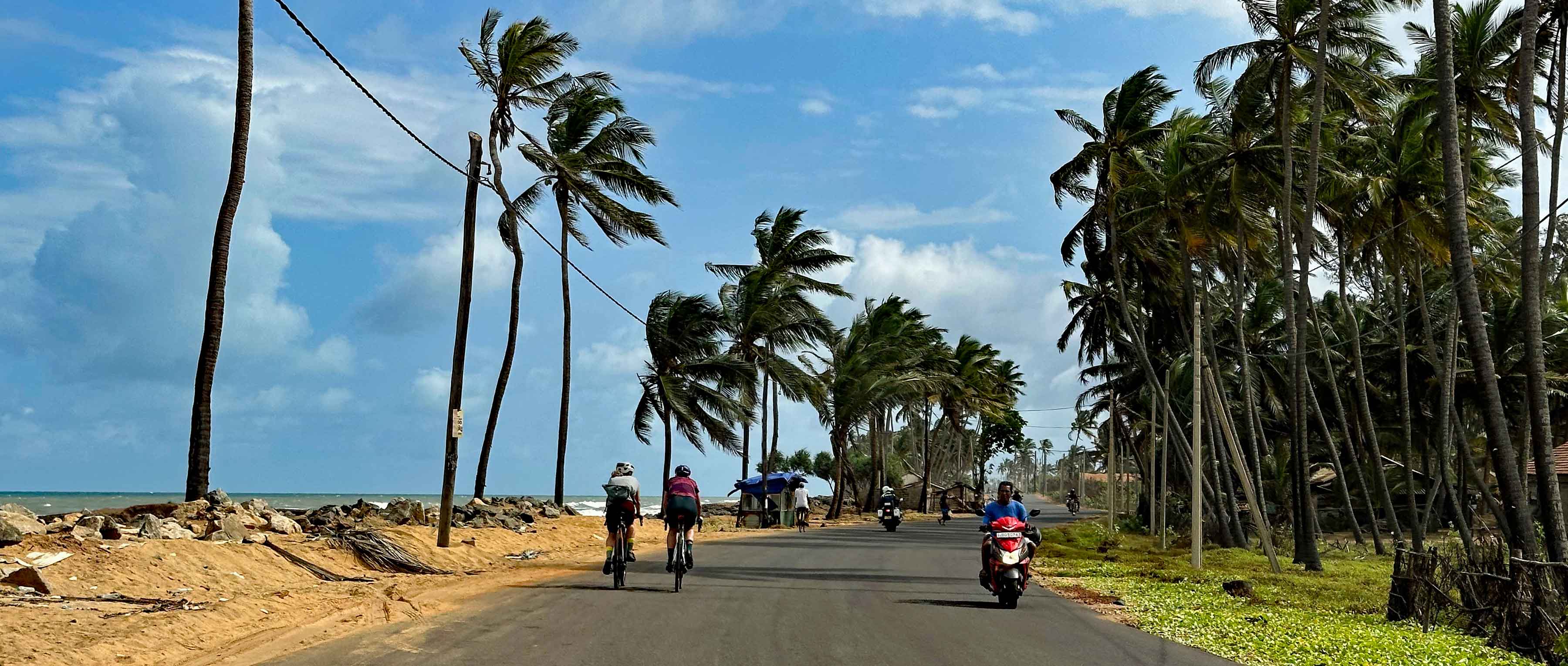
Our initial route was urban and took us northwards away from our overnight hotel in Negombo. A screaming tailwind was our (very welcome) guest on the first ride. We were given the full surround-sound experience of what cycling in Sri Lanka offers to visitors. Our route rapidly dived away from the busier main road and onto a half paved/half gravel road that ran just along the seashore. With breakers smashing onto a rocky beach just to our left and palm trees swaying overhead, it did really feel like we were riding in paradise. Practically every one of local people that we passed smiled, waved or said hello (and frequently all three at once).
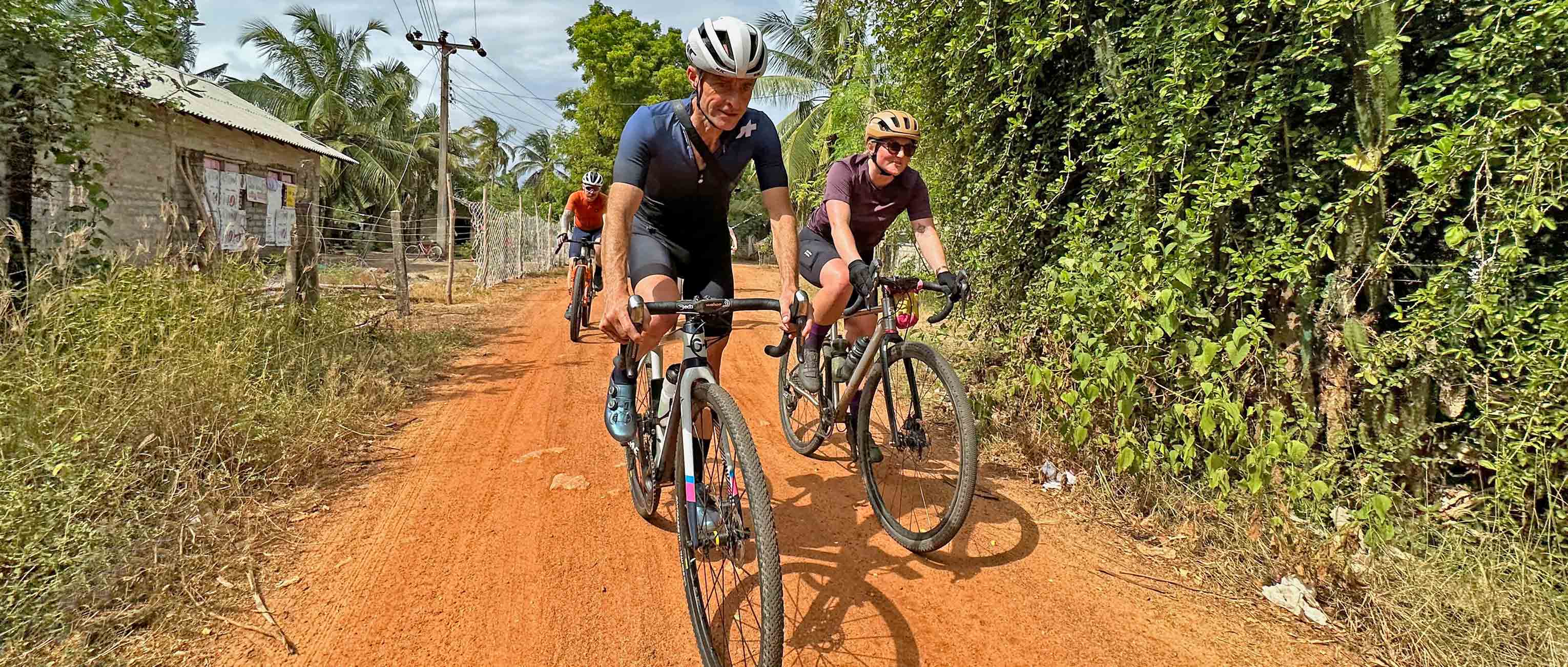
We were very rapidly far away from the tourist trail and experiencing the “real” Sri Lanka. We span past roadside fish markets, with the morning’s catch spread out on either side of our track to draw in potential buyers. At points, local people were drying home grown produce on the surface of the road, using the baking heat from the sun to remove any residual moisture before storage or sale at the nearby market. The route frequently turned off the already small road and onto hardpacked dirt tracks – absolute heaven on a gravel bike, although the early morning rain meant the surface was slightly tacky and we soon developed pretty impressive lower leg “tans” from the damp dust being flung up as we passed.

As the morning ticked by, temperatures were steadily climbing. My Wahoo recorded 30, then 34, then 38 degrees C. Pretty hot, even for a self-confessed lizard like me. Luckily the route planner had figured this southern part of our itinerary would be the hottest and just as we were starting to feel a bit boil-in-the-bag, we turned left and headed along an amazing red dirt road, deep into a coconut plantation.
Put a group of ridiculously enthusiastic gravel riders, who have been cooped on a long-haul flight, onto a perfect loamy dirt track through a shady coconut plantation and what happens? The speeds go up, the grins stretch ear-to-ear and you could feel the buzz being ratcheted up to maximum. It later transpired however that whereas the gravel riders all loved this section of the route, for many of our support crew (including our police motorbike escort), they had not spent much time riding/driving off-road in sandy conditions before. Just as we were whooping with joy, they were having some squeaky bum moments - trying to keep the motorbikes in particular upright and heading in the right direction proved to be somewhat of a challenge. 1-0 to the gravel riders then!
“Would you like to try a king coconut? We’ll teach you to drink it like a local, without a straw”. That sounded like way too much fun to turn down, so one of the plantation staff pulled out a machete from the back of his tuk-tuk and started to expertly chop the top off a small mountain of freshly harvested king coconuts. With single-use plastic straws now rightly frowned upon, we were taught how to sup from the coconut – cue lots of slurping noises, chins dribbling with coconut juice and general hilarity.
Our reccie trip included five days of riding, most of which were 100kms in length. The organisers had tried to balance riding versus off-bike activities, so that we got to experience as much of Sri Lanka as possible. The first day was designed as a warm-up (in all senses of the term) and over the length of the wind-assisted 100kms we climbed a spectacularly unimpressive 89m! Luckily our little group included former Dutch national road race champion and GCN presenter Iris Slappendel and if anyone was going to be an expert at pacing a group on flat roads, it would be her!
With a combination of an early start, a decent tailwind and flat terrain we flew through the morning’s route and after wiping off the dust-tan souvenir, were whisked to a local restaurant for lunch. Food and water levels topped up, we traded lycra for bush hats and climbed aboard open sided 4x4 vehicles for a guided tour of Wilpattu National Park. While we initially felt a little short-changed that we didn’t manage to spot any elephants or the elusive leopard, the afternoon was topped off in style with a super close sighting of a sloth bear who was casually rummaging in the undergrowth for good things to eat.
Our first day had set the pattern for the remainder of the trip. An early wake up call, an impressive buffet breakfast, rapid bag packing, followed by a morning of awe-inspiring riding on a mix of dirt tracks and low traffic paved roads. Everywhere we went, the local people smiled and waved. Although I was too slow to capture it on camera, early on Day 2 a local cycling club whooshed past, with many of the riders in full team kit including some Jumbo-Visma and Bora-Hansgrohe. Despite the full kit and decent speed, the riders were on local single speed Hero roadster bikes, complete with rod brakes. While we did see other cyclists, the vast majority were using their bikes as a tool rather than as a leisure pursuit and the majority of riders were older men, generally sporting impressive handlebar moustaches.
The single biggest benefit of bringing tourists to off-the-beaten track locations is the financial benefits we can offer to local people by using their services. Each day the organisers of our trip made sure we stopped at a locally owned roadside stall. We were able to try an amazing range of freshly prepared local food including rice hoppers (thin panckaes made from fermented rice and coconut milk batter), freshly squeezed juices of many varieties and a huge range of local fruit and veg, including mangoes and bananas so flavoursome you will never look at another imported version again. The income created by bringing a group of hungry cyclists to a roadside stall is vast, relative to the income created by sporadic local traffic, but the benefits are more than just financial – they’re cultural too.
Of our merry band of ten riders, seven were women. This helped create a really supportive, caring feeling within the group, but was also brilliant at breaking down some cultural barriers with the local people and within the support team too. As we got to know the support crew better, they would regularly take photos of us as we were riding and were frequently surprised at how resilient we were as riders. They were especially positive about how strong the women riders were. I appreciate how condescending that sounds, but in a patriarchal society like Sri Lanka, for the support team and the local people to see how much the women riders in the group thrived on the daily challenges of our ride will have hopefully had a positive impact.
The cultural exchange was two way, though. After we had finished our second day’s ride, we were whisked in a small convoy of tuktuks along narrow and bumpy dirt tracks and were deposited next to a tiny wooden shack in the middle of a huge area of rice paddies. Our lunch was one of the daily surprises that the crew had in store for us. It started with a head and shoulder massage for everyone followed by the arrival of four sari-clad local women bringing a range of traditional dishes for us to sample. The tradition in the predominantly agricultural area that we were riding through was for the men to work in the fields during the day and their wives to bring them their lunch, served in an earthenware pot bound in cloth to retain the heat. Eaten off giant banana leaves and wicker plates, we got some sample some absolutely delicious local dishes, many of which were unique to the area.
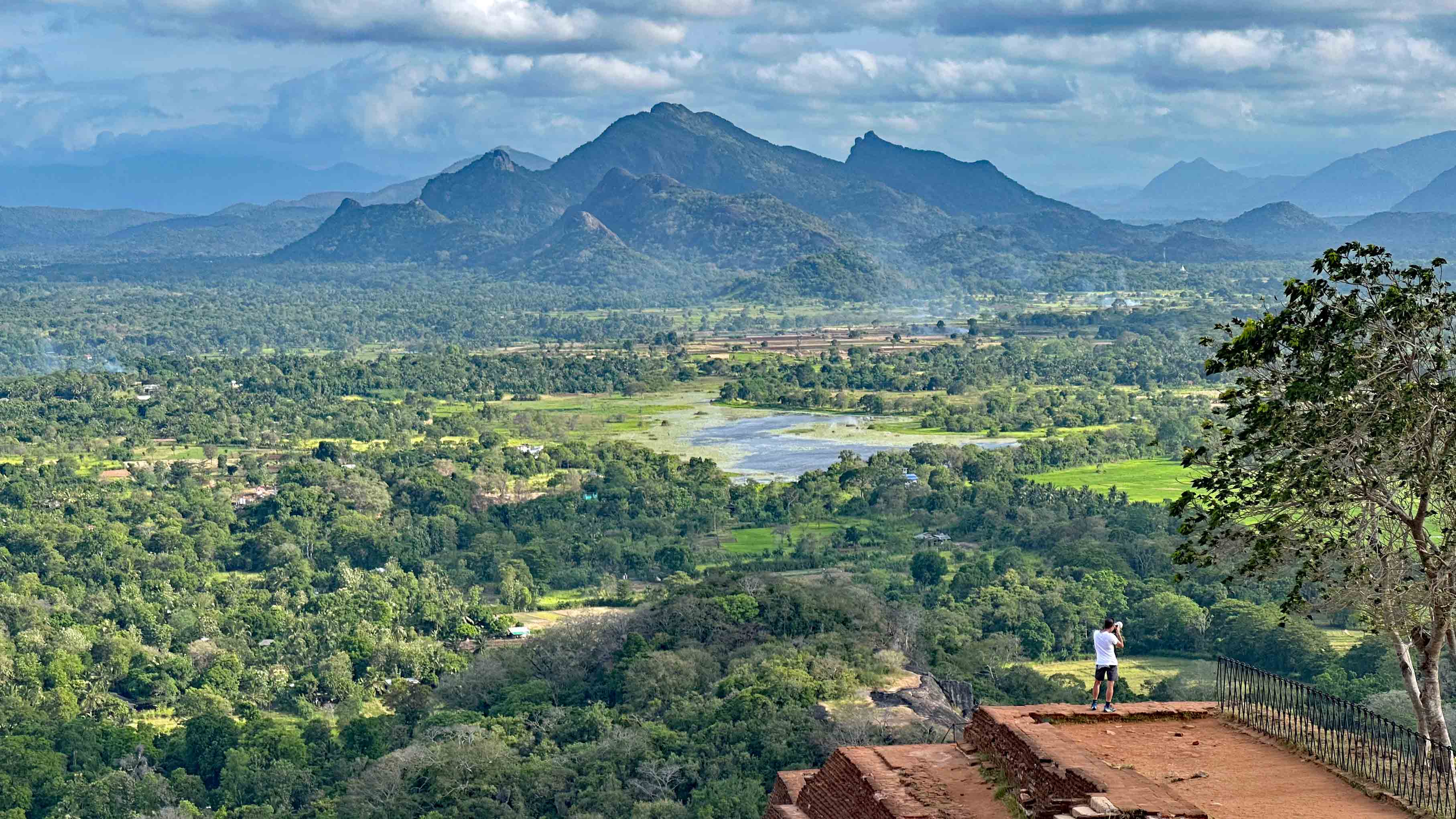
Post lunch, we were offered a choice of activities. For those who wanted a more leisurely afternoon, there was the option of being driven to our very luxurious overnight accommodation, complete with pool and extensive grounds to explore. For those with some extra energy to burn (and some tolerance of heat and vertigo) was to chance to go and climb to the top of the ancient rock fortress of Sigirya. Having watched it on TV in the UK not long before travelling out to Sri Lanka, this was too good an opportunity to turn down and it turned out to be an utterly spellbinding experience. The climb, up roughly 1000 metal and stone steps, was pretty challenging in the mid-afternoon sunshine, but the view from the top was breath-taking and made the effort worthwhile.
After a night spent in utterly luxurious accommodation, complete with lakeside pre-dinner drinks and electric golf buggies on call to ferry us and our luggage around, we set off on the Queen Stage. Although it was “only” 100kms, our route included the impressively tough Riverston climb, which included sustained pitches of more than 20% and temperatures of high 30s degrees C.
Our day started off perfectly. A gentle spin beside the Kandalama Tank, lit with perfect early morning sunshine, was soon followed by turning off onto my favourite gravel track of the route. Initially a smooth, fast-rolling gravel track next to stunningly vibrant rice paddies, it soon turned spicier with a short, steep, water-eroded ramp which climbed back up towards the closest tarmac road. This section proved barely passible for our fleet of motorbikes, but perfect for gravel riders with an MTB background. It showed us the potential for stunning, challenging gravel riding in Sri Lanka.
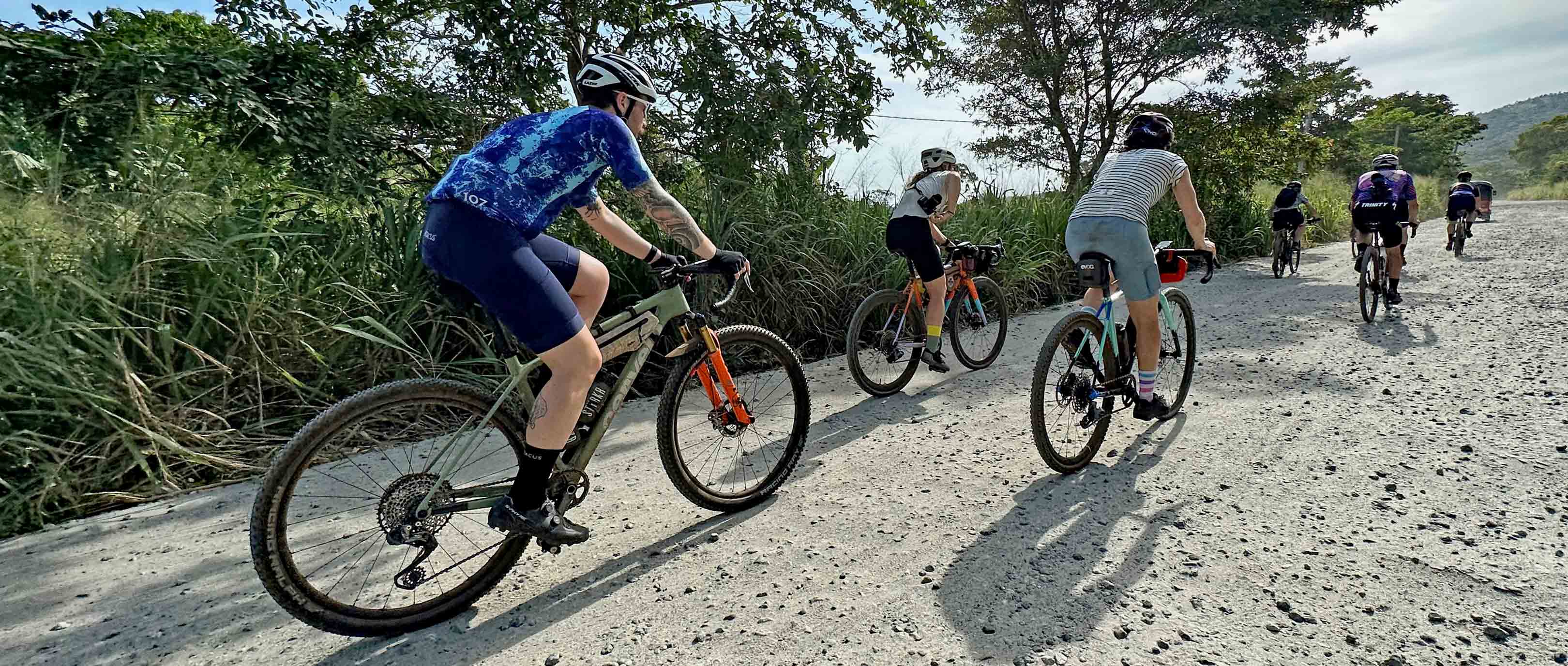
It also made us realise how vast the challenge would be to research, map and categorise the sheer number of dirt tracks, gravel roads and walking trails used by local people. Due to a combination of safety requirements by the airline and the time constraints required to research potential trails, not to mention the learning curve required by the local team to figure out the appropriate level of challenge that gravel riders would be up for, the proportion of paved-road riding that we did was at times a little more than we would have liked. The flipside is that by given us tantalising glimpses of how stunning the gravel trail network was, it really whetted our appetites and made us want to come back for more.
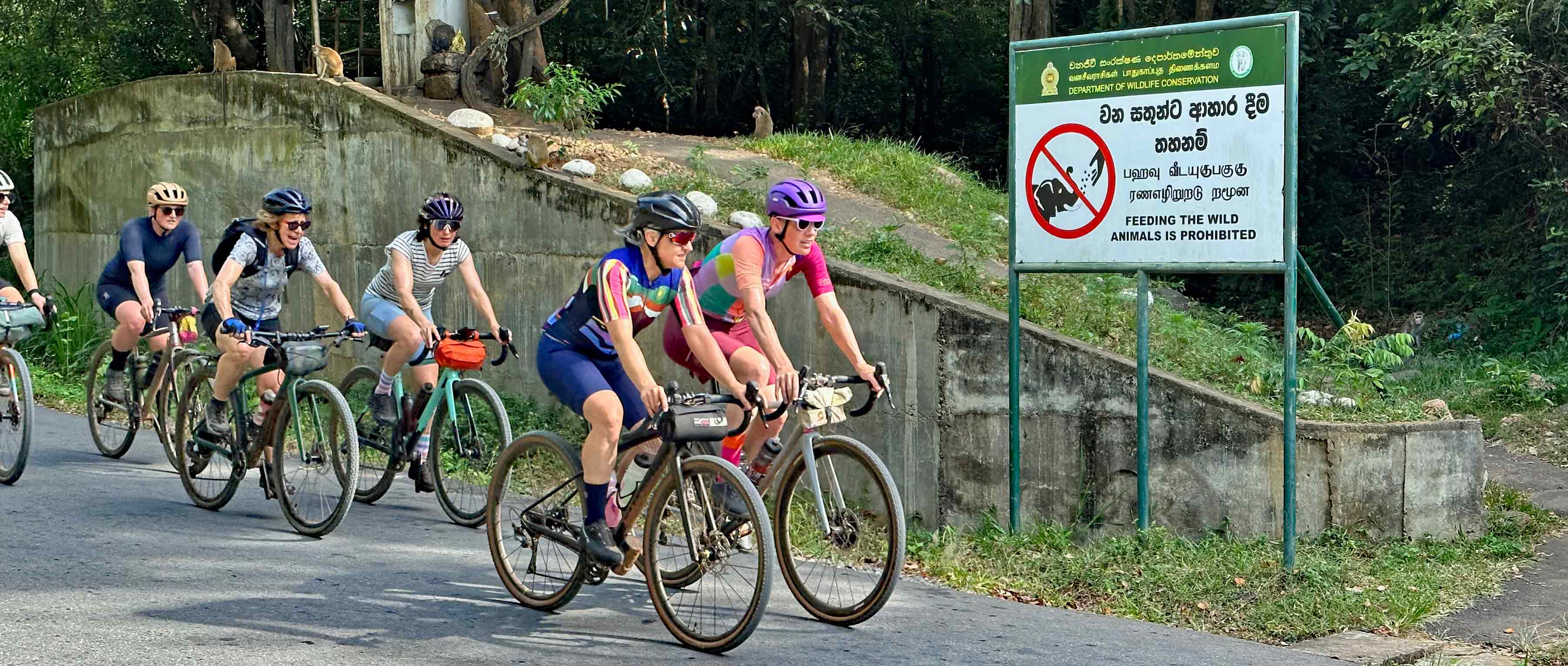
As the week progressed, it was great to see that the local team really began to “get” what made gravel riders tick (and how much of a challenge we were capable of undertaking). The fact that we were frequently able to ride faster and more safely than our supporting fleet of motorbikes and vehicles could, proved to be a real eye-opener for the local team. That and how much food and drink we needed to consume to keep us fuelled during our journey!
After a night in our most luxurious hotel yet, complete with vast open-sided dining room, riverside view and bone-china tea set in each room, Day 4 saw us starting off with a different range of transport as we let “the train take the strain”
If you had told me in advance than one of the highlights of our Sri Lankan gravel riding trip would be a four-hour train journey from Kandi to Ohiya I would have laughed in your face. What I didn’t appreciate though, was that this was a pretty special train journey. Although by western standards, the journey is slow and in places pretty noisy, the scenery is mind blowing. The line climbs almost constantly from where we joined in Kandy and Ohiya and reaches 1791m in altitude. The line weaves through vast swathes of agricultural land, before climbing into tea plantations and broadleaf forest. With a slightly more relaxed view of passenger safety than generally found in Europe, the doors of our 3rd class carriage remained open for the entire journey and I took up a strategic position in one of them, frequently hanging out to take in even more of the impressive views.
With a starting altitude significantly higher than the tallest mountain in the UK, we knew that the riding portion of Day 4 might be a bit of shock to the system. Our route initially took us on broken tarmac up through stunning broadleaf forest, fortunately providing shade from the impressively strong sunshine. With sustained pitches of 10% and gradients of up to 20% in places, the opening climb proved to be quite a challenge, but as we arrived to the entrance gate to the Horton Plains National Park, the effort was worthwhile.
With an average elevation exceeding 2100m, the difference in temperature was noticeable. Although our route through the park was on a (broken) paved road, rather than on gravel, the views and the wildlife were stunning. Large herds of deer stood watching us from the roadside and with foreboding skies and lower temperatures, at times it felt like we were riding through the highlands of Scotland.
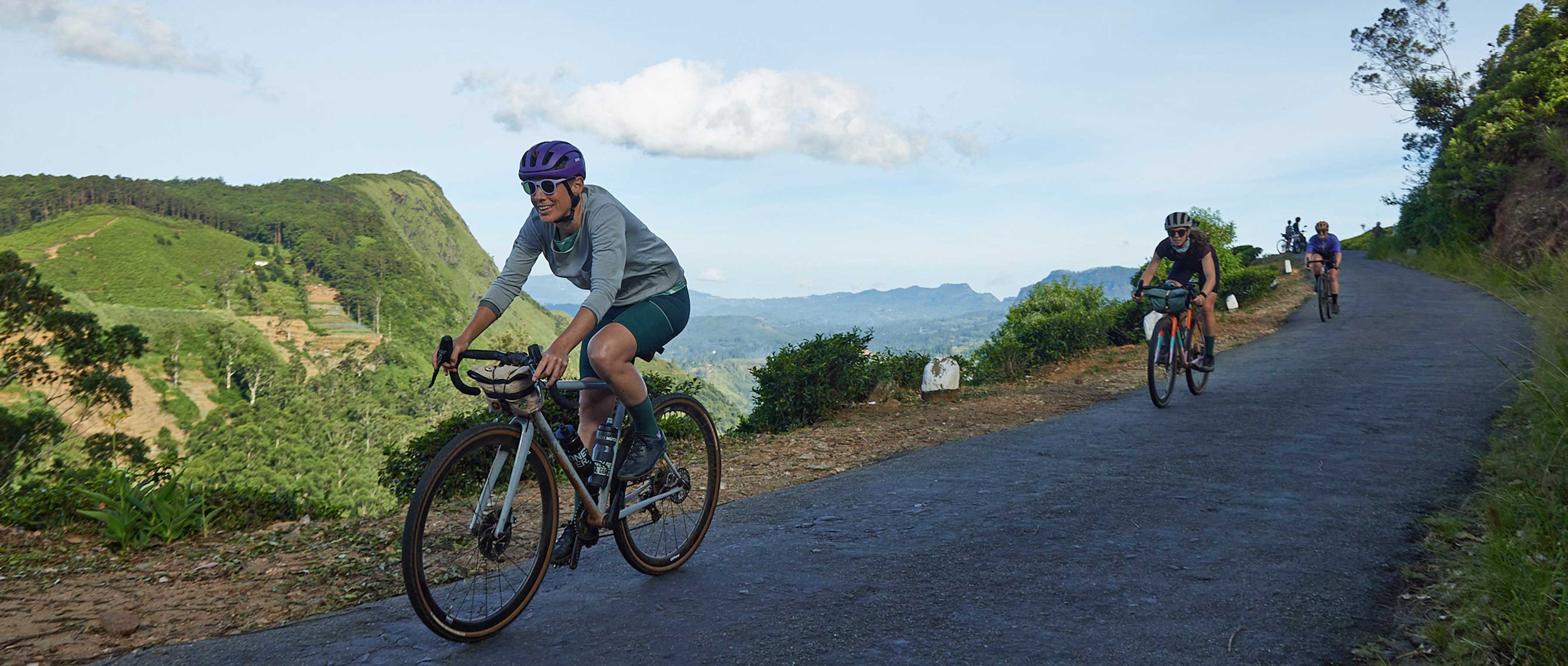
Image courtesy of Michael Blann
The highlight of the riding was an incredible 30km descent. Again paved, although in the loosest sense of the term in the upper section, the first five kms were incredibly fast, hairpinned, steep and with stunning views all around. It wasn’t possible to do justice to the views and focus on the riding, but the road was so fun that we all seemed to arrive at the bottom wishing we had stopped to take some photos! Next on the riding menu was some incredible smooth, flowy descending – a real balm after the broken and steep nature of the upper section. As the gradient eased and sightlines improved, our speeds went through the roof. Chris who was riding behind the police motorbike recorded significantly above 70kph and I reached my limit of skills/confidence/grip while trying (and failing) to follow group coordinator Helen on one of the twistier sections. Fortunately, we all arrived safely at the bottom and re-grouped next to an open sided fruit and veg shop, where we tested out even more of the incredible varieties of banana on offer in Sri Lanka.
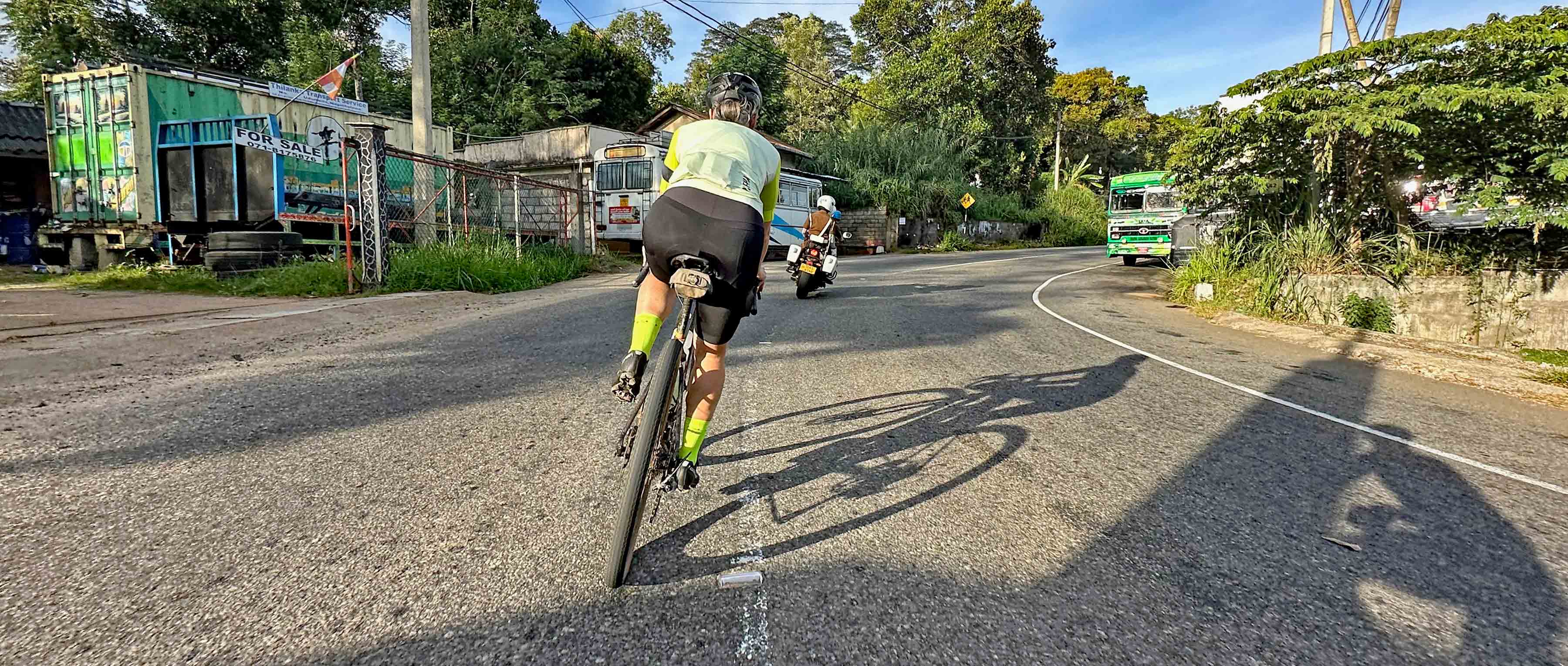
At this point, group organiser Sarunjan broke the sad news to us that due to ever encroaching arrival of sunset, we wouldn’t have time to complete our proposed route and we would have to cut it short. With our police motorbike escort doing an incredible job of clearing our path, we tried to race the impending arrival of sunset and flew down the next section of descent. As we arrived at a flatter section towards the bottom, the smell of scorching-hot motorbike brakes showed quite how hard Mayura and Krishnan had been pushing the pace on the police bike in order to help us to get to our finish point before dark. The size of their grins told us how much they were enjoying working with a bunch of mad gravel riders too.
Day 5, our final one of riding, saw an early start at our overnight tented camp accommodation. I initially felt pretty under-the-weather after sub-optimal levels of sleep and a very atypical minimal breakfast, but a hairpinned 20km descent complete with stunning views across the surrounding scenery, plus the infectious, ever-positive attitude of my ride buddies soon revived my spirits. We had chosen to wear party shirts for our last day of riding and everyone we passed gave us a cheery smile and a wave. While I’m not going to be trading in my high-tech hot weather riding gear anytime soon, I can’t deny that the bright colours did indeed create a party atmosphere as we hurtled off the mountain.
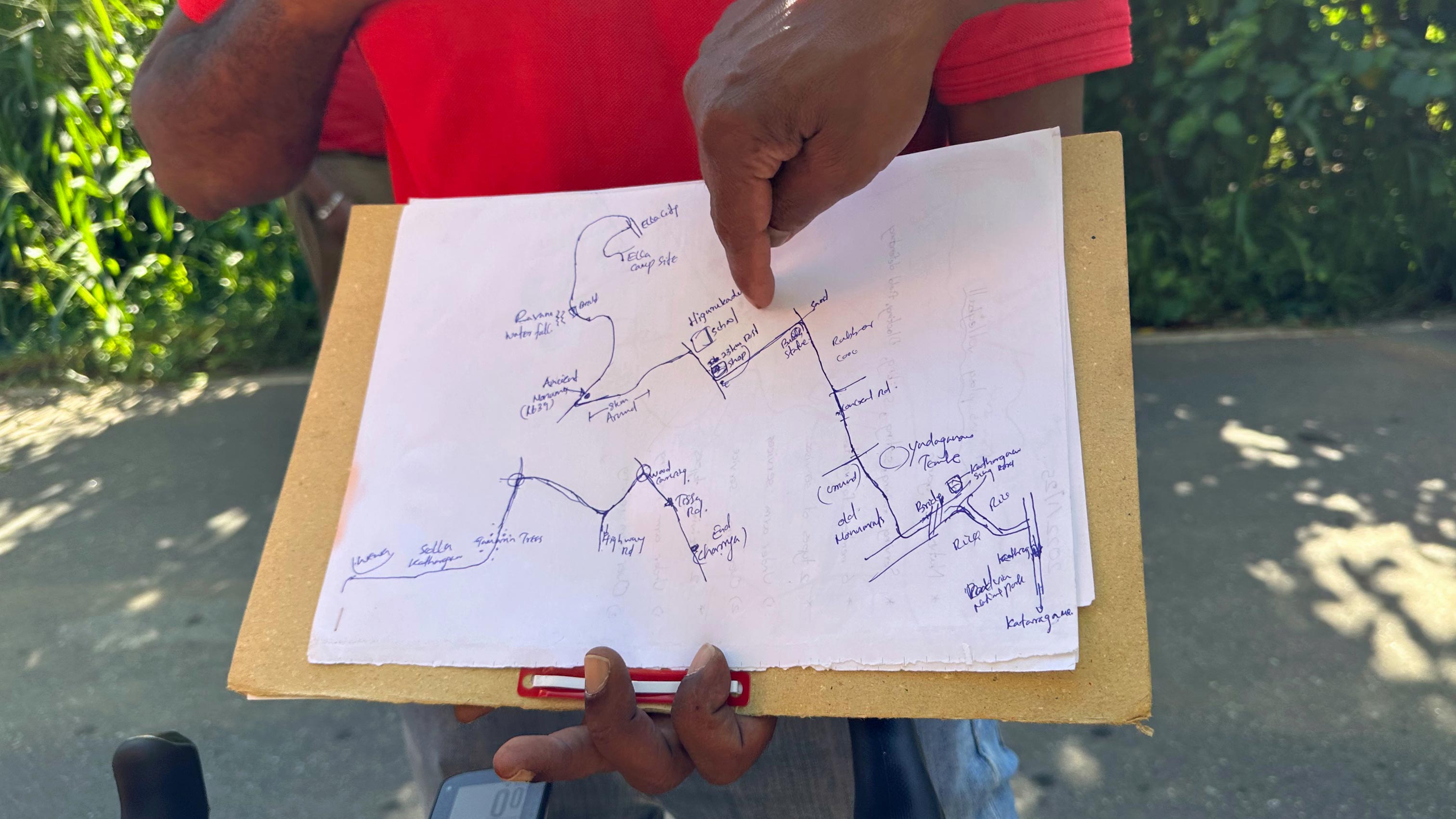
After a mid-morning snack and water stop, pro photographer Michael and I decided to head a little further up the road to capture some shots of the group as they came towards us. Ideally, we wanted some rice paddy fields, so checked with the support crew if they knew of any suitable locations. At this point, the main organiser pulled out a clipboard with a hand drawn map of the day’s route. Not only did it show every junction, but their map also showed in specific areas what was beside the road – perfect for us to identify the ideal spot. While the riders were using high-tech GPX files to help navigate the twists and turns, it just goes to show that old fashioned methods work just as well.
Up until this point on Day 5, our route had been 100% paved and Michael and I were starting to get a bit antsy about finding some gravel to ride. At this point our high-tech approach to route finding paid off and I spotted a small road which ran parallel to the one we were supposed to be riding on. With only a few seconds to figure out if it would join up, I then told Michael of my plan and we peeled off left, away from tarmac and onto a pristine gravel road which ran through a partially forested agricultural area. With a combination of skill, zen and luck we managed to find a few kms of completely perfect gravel riding, running parallel to our route. I figured we should turn back and try and take the rest of the group along it too, but they were riding much faster than we had anticipated and no sooner had we turned around, than we met them coming towards us.
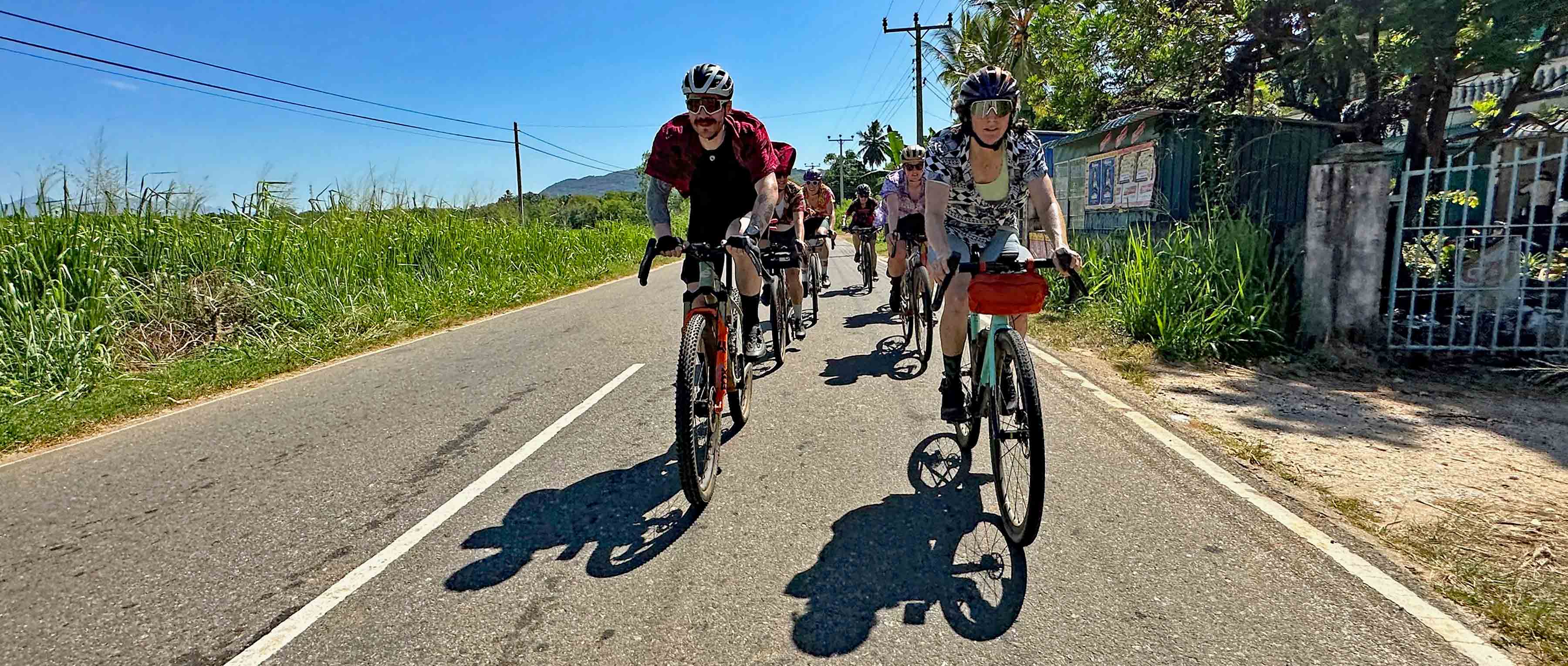
This neatly highlighted the biggest conundrum of gravel riding in Sri Lanka. There clearly are vast networks of gravel tracks just waiting to be explored, but the time and effort required to reccie them all would be enormous. Our local team also explained the system of land ownership in Sri Lanka means that often these tracks are privately owned and while a couple of riders can use them without any problems, taking a full convoy of riders and support team along them, without first having arranged permission from the relevant landowner would be a potential issue.
Our final (and now traditional) mid-morning surprise organised by our support team was a stop at a roadside fruit seller and café. On one side of the road were mountains of delicious fresh fruit for sale, but on the other side was a small café where the owner ably demonstrated the skilful production of Sri Lankan hoppers. In a tiny wood smoke filled kitchen, the café owner cooked platefuls of delicious hoppers and pol rotis, which we inhaled with the gusto of riders with nearly 500kms under our belts.
With our last day of riding drawing to a close, the organisers had one last trick up their sleeves to make our trip finish with a bang – the chance to ride through the edge of Yala National Park, home to around 350 Sri Lankan elephants. As cyclists are only permitted to travel through the park with the assistance of national park guides, we duly bunched up and road en-masse along the park’s main north-south road. There was a tangible sense of anticipation as we headed south and we weren’t disappointed! On three occasions we spotted these majestic animals quietly minding their own business in the middle of the road. With some expert wrangling from the park guides, the elephants changed course and headed off into the surrounding bush and we were able to travel on to our finish point for the day and our whole riding journey.
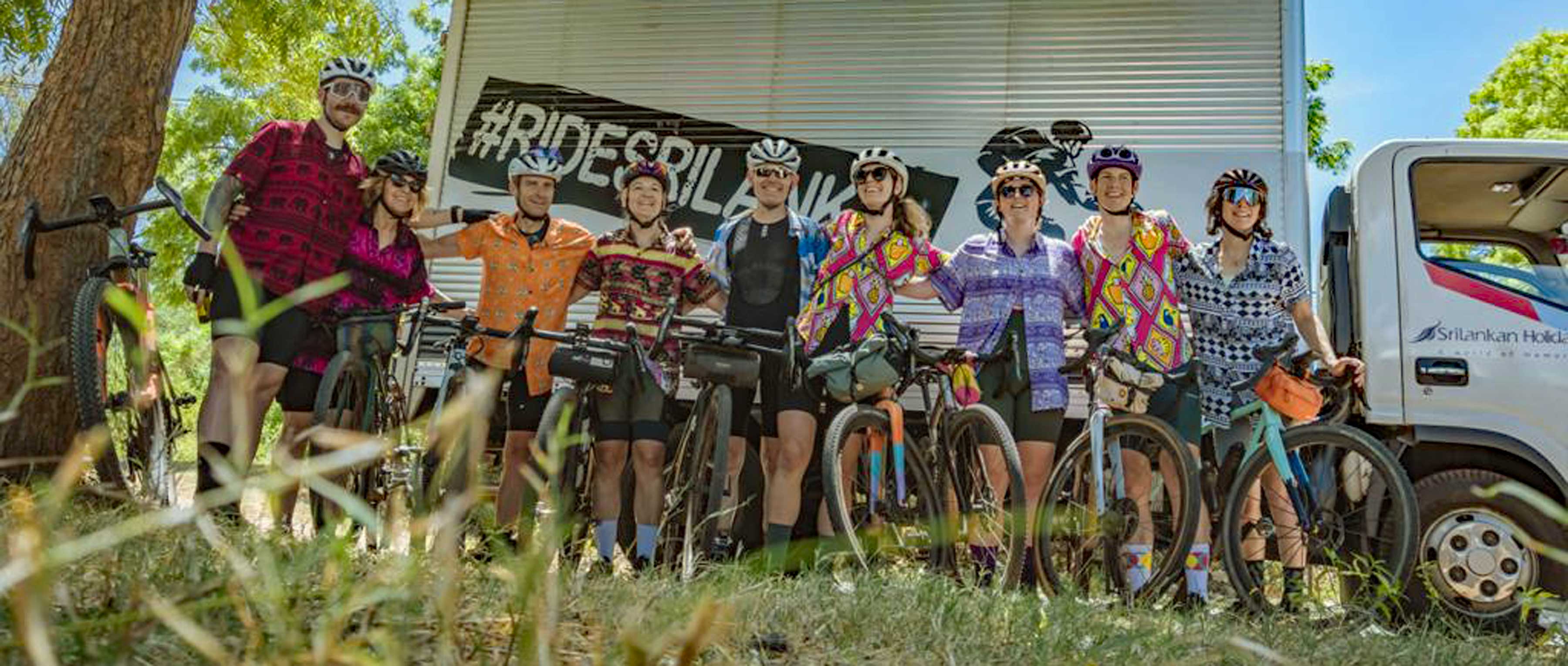
Image courtesy of Sri Lanka Airlines
There’s something remarkable about gravel riding, that it brings riders from disparate backgrounds together incredibly rapidly. Having been essentially strangers less than a week earlier, the final image really captures how well we had gelled and what strong bonds of friendship we had managed to cultivate in such a short period of time. The fact that we been offered the opportunity to discover the breathtaking scenery, culture, people, food, wildlife and not forgetting, gravel trails of Sri Lanka was something we were all incredibly grateful for.
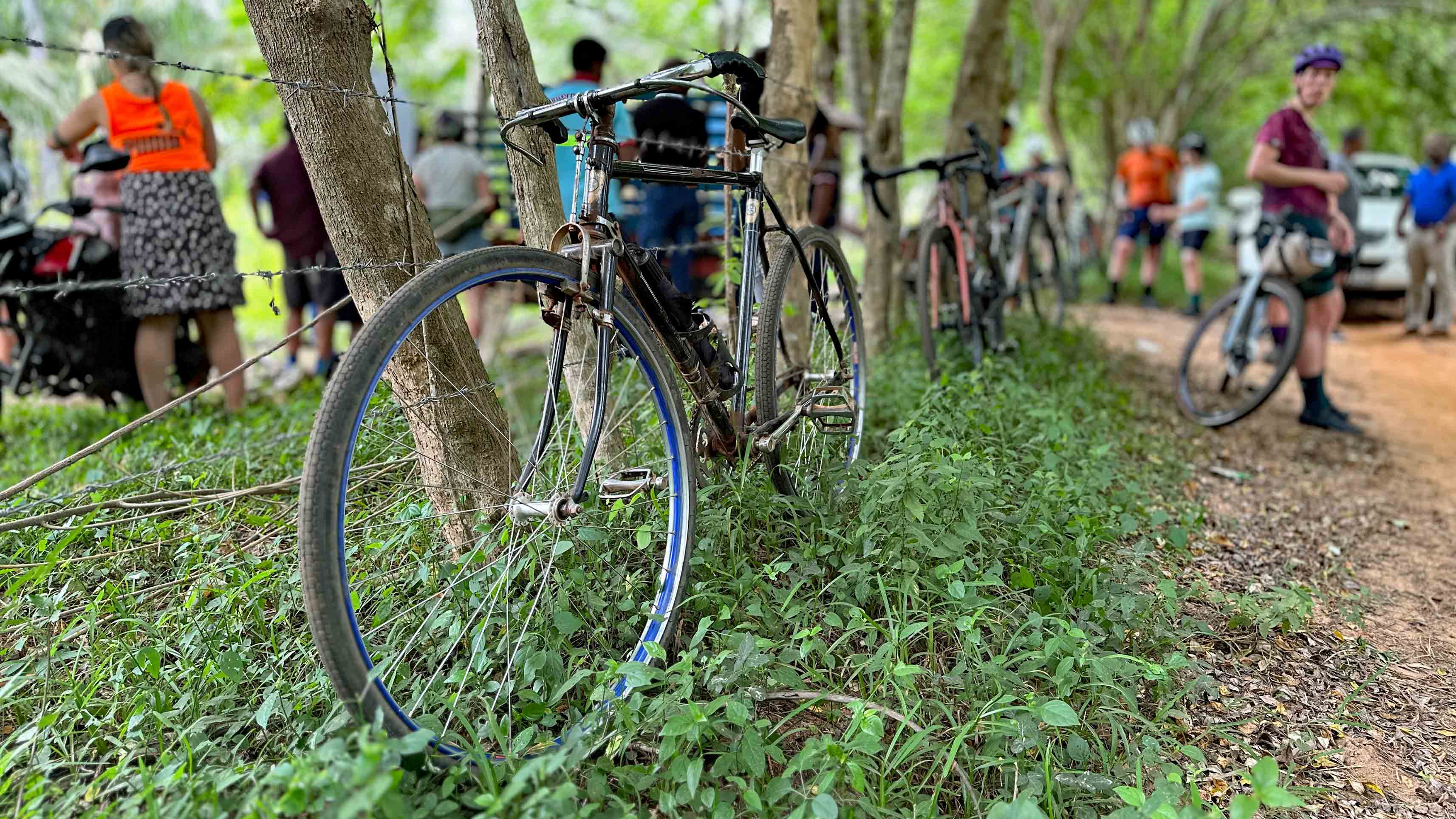
In the course of a week, we had barely scraped the surface of the potential for gravel riding in this remarkable country and we all went home buzzing with ideas of how we could do our bit to help guide its future course. While gravel riding in Sri Lanka is very much in its infancy and you won’t yet find the infrastructure and resources in place that you might find in other destinations, don’t let that put you off. Part of the thrill of gravel riding is discovering somewhere new and exciting and with Sri Lanka that thrill will be a visceral one that you won’t forget in a hurry.
Thanks so much to Sri Lanka Airlines for their incredible generosity in sponsoring this trip. In order to help promote cycle tourism in Sri Lanka in the future, the airline are going to offer free bike transport to customers travelling with their own bike. Check out their website for more details.
Thanks also to the amazing team of riders that I was lucky enough to spend a week in gravel paradise with. Ali, Amy, Cadzy, Chris, Gaby, Helen, Iris, Katherine, Michael and Sarunjan – it was an absolute pleasure to have met and ridden with you all.